Humidity considerably affects your living fence’s health and durability. In high-moisture areas, select tropical plants that thrive in humidity, while drier regions need drought-resistant species. Prevent rot by ensuring proper airflow, applying protective sealants every 2-3 years, and maintaining plant clearance around wooden elements. Regular inspections after rain help catch mold early. Creating microclimate zones with strategically placed vegetation enhances biodiversity while managing moisture levels. Discover how these strategies can transform your barrier into a resilient ecosystem.
How Humidity Levels Affect Plant Selection for Living Fences
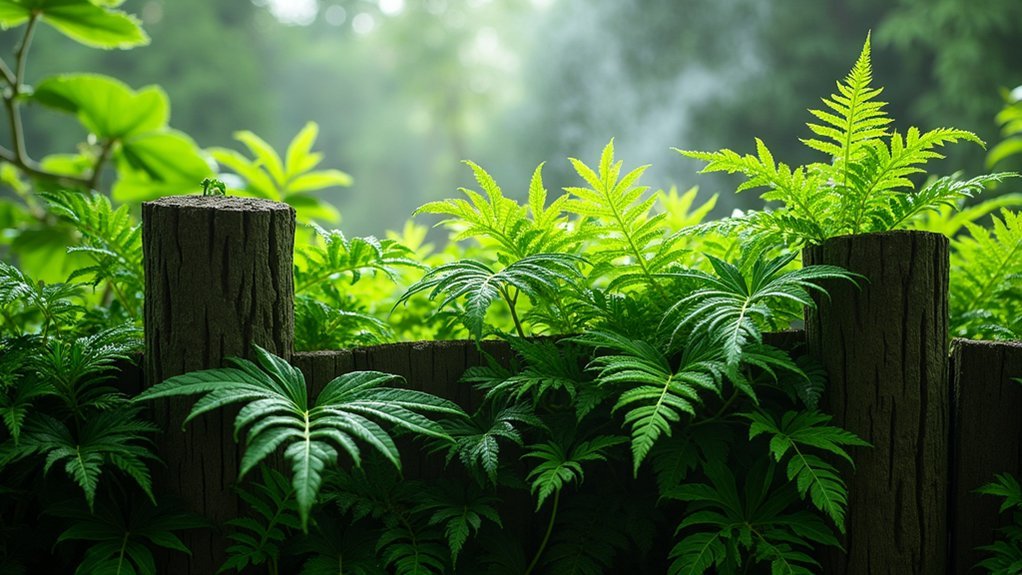
When selecting plants for a living fence, understanding humidity’s fundamental influence on plant physiology is essential for success. Your local climate’s humidity patterns will determine which species will thrive in your living barrier.
Tropical and subtropical plants flourish in high-humidity environments, maintaining healthy turgor and lush foliage. If you’re in a moisture-rich area, these make excellent choices. Research shows maintaining an indoor humidity level of 40-60 percent is optimal for both human health and plant growth.
For drier regions, consider xerophytic or drought-resistant species that avoid fungal issues common in humid conditions.
Evergreens require consistent humidity to maintain the dense foliage needed for privacy, while deciduous shrubs typically prefer moderate levels to support vigorous growth.
In coastal or variable humidity regions, opt for salt-tolerant and humidity-flexible species that can adapt to changing conditions without compromising your fence’s integrity and appearance.
Managing Moisture to Prevent Rot and Decay in Fence Structures
You’ll need to apply protective sealants regularly to create an effective barrier against moisture that causes rot in fence structures.
Ensuring proper air circulation around your fence helps manage humidity levels, even in the most challenging climates.
Regular pruning techniques help maintain airflow through living fence barriers, preventing excess moisture buildup that can lead to disease and decay.
Consider installing your fence with small gaps between boards and clearing vegetation that blocks airflow to maximize drying after wet weather.
Protective Sealants Matter
Protecting your living fence from moisture stands as one of the most essential maintenance tasks for guaranteeing its longevity.
The right sealant creates a robust barrier against water penetration, preventing the wood from swelling, warping, and developing fungal growth.
You’ll find several effective options: clear sealants preserve natural wood appearance while providing UV protection; tinted stains add color with enhanced defense; and eco-friendly plant-based options offer sustainable protection. For optimal protection at a reasonable price point, consider WoodRx products which offer coverage ratings above 4.2 while being more affordable than other wood preservatives.
Before application, thoroughly clean your fence with a power washer and confirm it’s completely dry.
Apply at least two even coats, focusing on lower sections that face higher moisture exposure.
Most fences require resealing every 2-4 years, though annual cleaning and regular inspections will help you spot issues before they become serious problems.
Air Circulation Solutions
Proper air circulation serves as the unsung hero in your fence’s battle against moisture damage. By incorporating gaps between fence slats, you’ll greatly improve airflow while reducing moisture retention that leads to rot.
Consider wind-permeable designs like lattice or trellis fencing that balance structural integrity with air permeability. Strategic vent placement creates natural pathways for air movement, keeping your fence structure dry even in humid conditions.
Don’t overlook material choices—composite options like Novowood offer excellent air circulation while maintaining durability. The innovative Air Flow version features 80 mm gaps between slats that perfectly balance protection and ventilation.
For existing fences, verify regular cleaning to prevent debris buildup that blocks airflow.
Remember that fence height impacts air movement; lower sections generally allow better circulation.
Creating Microclimate Zones Within Your Living Barrier
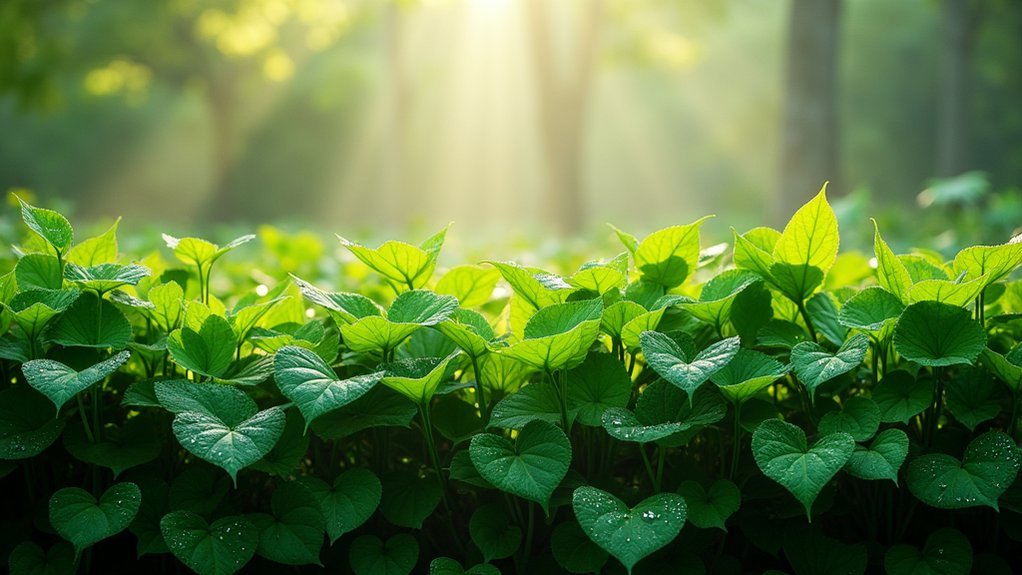
Creating purposeful microclimate zones within your living fence transforms a simple barrier into a thriving ecosystem.
You’ll boost biodiversity by strategically placing moisture-loving plants in natural collection areas while positioning drought-tolerant species along exposed sections.
These moisture gradients benefit your entire landscape by stabilizing humidity levels, reducing watering needs, and creating specialized habitats for beneficial insects and wildlife. Pairing your living fence with solid panel sections can raise adjacent planting zones’ temperatures by up to 15°F on sunny days, creating exceptional growing conditions for heat-loving vegetables.
Strategic Plant Placement
When you strategically position plants within your living fence barrier, you’re not just creating a boundary—you’re engineering a thorough microclimate system that can dramatically alter growing conditions.
Leverage the natural properties of different species to control humidity and airflow throughout your garden.
- Position moisture-loving plants on the leeward side of your fence where they’ll benefit from reduced wind exposure and accumulated humidity.
- Create U-shaped sun traps with a 2:1 height-to-distance ratio to capture both heat and moisture while blocking drying winds.
- Layer vegetation with canopy trees, mid-height shrubs, and groundcovers to create multiple humidity zones within the same barrier.
- Integrate native, disease-resistant species like Ceanothus with high-transpiration plants to balance moisture levels naturally.
Carefully selecting plants that match your specific sunlight availability ensures they’ll thrive in your microclimate and maintain optimal humidity levels throughout the seasons.
Moisture Gradient Benefits
The strategic manipulation of moisture gradients within your living fence barrier reveals a spectrum of microclimate possibilities that standard fencing simply can’t provide.
By controlling humidity levels, you’ll enhance both functionality and biodiversity simultaneously.
Your living barrier can segment into distinct zones, each supporting different plant varieties through tailored moisture conditions. This zonation not only optimizes growth conditions but also strengthens your barrier’s resilience against climate fluctuations.
You’ll see tangible benefits beyond aesthetics: reduced energy costs through improved insulation, minimized pest infestations, and enhanced structural preservation of adjacent buildings.
In humid climates, proper moisture management prevents foundation damage and eliminates musty odors while maintaining air quality. Maintaining humidity levels between 50% to 55% creates ideal conditions for your living fence while discouraging mold growth in surrounding structures.
With thoughtful moisture gradient planning, you’re not just building a fence—you’re crafting an adaptable, energy-efficient ecosystem.
Seasonal Humidity Fluctuations and Barrier Adaptation Strategies
Living fence barriers respond dynamically to seasonal humidity changes, presenting both challenges and opportunities for property owners.
Late summer and early fall humidity peaks can increase moisture retention in your living fence, potentially fostering fungal diseases while simultaneously benefiting deeply rooted plants.
You’ll need different strategies to adapt your living fence to these fluctuations:
- Position your fence away from water sources and incorporate drainage systems to prevent excessive moisture accumulation
- Leave breathing space within your fence structure to enhance airflow and reduce moisture buildup
- Apply protective coatings to wooden components and choose moisture-resistant materials like cedar for non-living elements
- Schedule pruning during low-humidity seasons to minimize disease spread when humidity rises
Regular monitoring for early signs of pest infestations becomes crucial during humid periods, as many insects thrive in moisture-rich environments that living fences provide.
Balancing Water Retention and Drainage in High-Humidity Areas
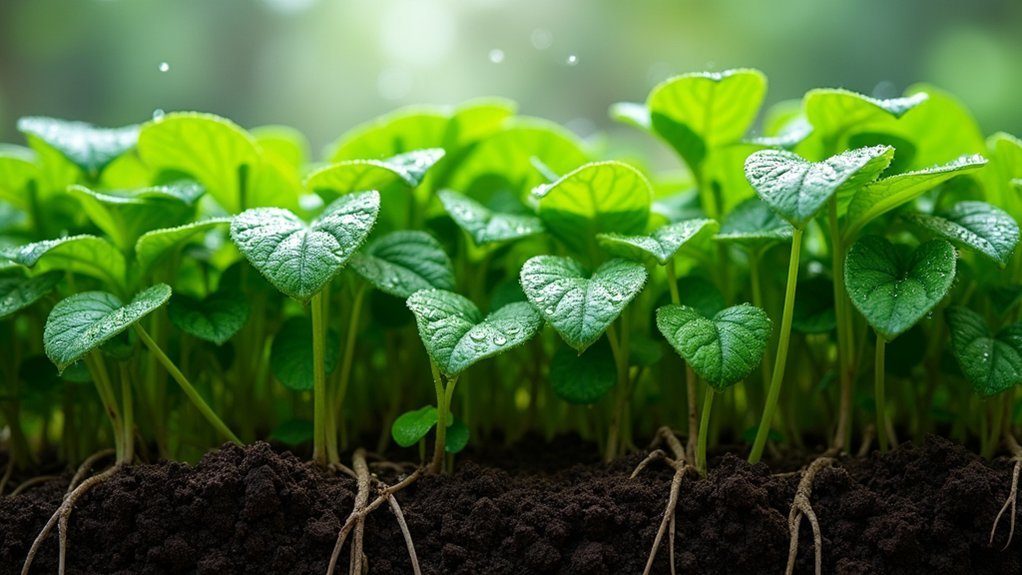
Maintaining the delicate balance between water retention and drainage presents a significant challenge for homeowners with living fences in high-humidity regions. You’ll need to select appropriate materials like non-woven geotextiles that allow water flow while preventing soil erosion.
Your drainage system design must account for your specific soil type and local climate conditions. Consider installing HDPE barriers under fences to divert excessive runoff while strategically selecting vegetation that supports water management. The waterproof properties of HDPE barriers make them particularly effective in high-moisture environments.
| Drainage Element | Purpose | Best for High Humidity |
|---|---|---|
| Non-woven Geotextiles | Prevent erosion | Clay-heavy soils |
| HDPE Barriers | Divert water | Fence perimeters |
| Root Barriers | Control moisture | Near structures |
| Staked Turbidity Barriers | Manage stormwater | Sloped areas |
| Drainage Channels | Redirect flow | Areas with heavy rainfall |
Remember to maintain your drainage systems regularly to guarantee ideal performance in managing humidity’s effects on your living fence.
Protecting Your Living Fence From Mold and Mildew Damage
Beyond water management, high-humidity environments present another significant threat to your living fence: mold and mildew.
These fungal invaders thrive in damp conditions, potentially causing structural deterioration and unsightly discoloration if left unchecked.
Protect your investment with a multi-layered defense strategy that combines preventive treatments and regular maintenance.
A strategic approach to preservation ensures your living fence remains both beautiful and durable against fungal threats.
Apply UV-blocking sealants every 2-3 years to create a moisture barrier, and maintain proper airflow by establishing a 1-foot clearance between plants and your fence. In cases of severe growth, a pressure washer can effectively remove stubborn mold when used with appropriate PSI settings for your wood type.
- Use a 3:1 water-to-bleach solution for treating existing mold on untreated wood
- Create gravel borders to improve drainage in persistently damp areas
- Conduct seasonal inspections after rain or high-humidity periods
- Apply vinegar-water solutions (½ cup per gallon) for gentle cleaning of early-stage growth
Enhancing Biodiversity Through Humidity Management
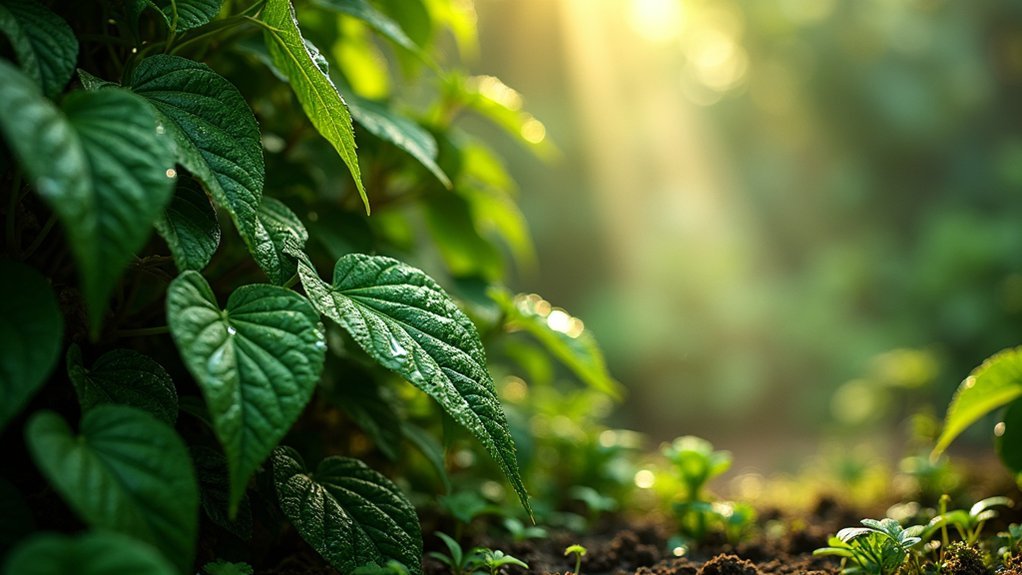
While your living fence provides a gorgeous boundary for your property, its impact extends far beyond aesthetics into creating essential ecological corridors.
By selecting species with high transpiration rates like Siberian pea-shrub, you’re naturally increasing local humidity levels. This enhanced moisture creates microhabitats that support diverse wildlife.
The humid environment particularly benefits seedling establishment, amphibians, and beneficial insects. You’ll notice increased pollinator activity as moisture-supported flowers thrive along your fence line. Native flowering shrubs in your living fence provide essential nectar and pollen for local pollinators throughout the seasons.
Your fence can host over 60 tree species in some regions, far exceeding biodiversity in adjacent pastures.
Include a mix of light-demanding and shade-tolerant plants to create layered vegetation structures. Remember that 70% of living fence species rely on birds for seed dispersal, so your humidity management directly supports avian biodiversity throughout your landscape.
Climate-Specific Maintenance Practices for Living Barriers
As climate patterns shift dramatically across regions, your living fence requires tailored maintenance strategies to withstand local environmental challenges.
You’ll need to adapt your approach based on your area’s unique climate stressors, from flooding to heat waves.
- Install effective drainage systems around fence perimeters to prevent water damage during heavy rainfall and flooding events.
- Apply mulch regularly to regulate soil temperature and retain moisture, especially essential during extended heat periods.
- Implement early warning response plans for extreme weather, including temporary reinforcements before major storms.
- Engage your community in collaborative maintenance efforts, sharing resources and knowledge to enhance overall resilience.
Data shows that Norway experienced a 20% increase in precipitation over the last century, highlighting the importance of moisture-resistant materials for living barriers.
Remember that regular inspections will help you identify climate-related issues before they compromise your living barrier’s integrity.
Long-Term Structural Integrity in Varying Moisture Conditions
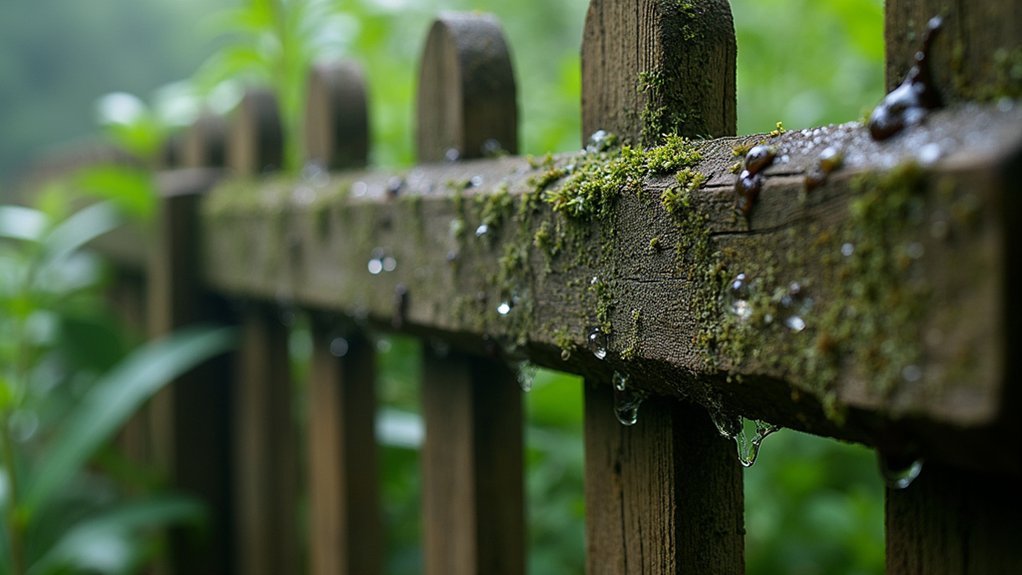
Maintaining your living fence’s structural integrity depends critically on how you manage humidity and moisture conditions over time.
Your fence materials respond differently to moisture exposure—wood swells and weakens through repeated wet-dry cycles, while even vinyl can develop mold in humid conditions.
You’ll see better performance by preventing water accumulation at fence bases. Installing gravel layers improves drainage and reduces the moisture that accelerates rot.
For wooden components, avoid direct soil contact and consider pressure-treated options that resist decay.
In coastal areas, you’ll need to address salt-laden moisture that speeds up corrosion. Regular cleaning prevents organic buildup that traps moisture, while proper site drainage prevents water pooling that undermines posts.
These preventive measures greatly extend your fence’s functional lifespan in challenging humidity conditions.
Aluminum fencing provides an excellent alternative in areas with high precipitation levels since it resists rust and maintains structural integrity even in consistently damp environments.
Frequently Asked Questions
Can Living Fences Impact Property Insurance Rates?
Yes, living fences can reduce your insurance rates as they enhance security, decrease liability risks, and add property value. You’ll want to maintain them properly and consult your specific insurer about potential discounts.
How Do Living Fences Affect Noise Reduction in Humid Environments?
Living fences reduce noise more effectively in humid environments as moisture increases leaf density and sound absorption. You’ll notice better dampening of traffic sounds when your plants retain more water and maintain fuller foliage.
Are There Electromagnetic Shielding Benefits From Certain Living Fence Plants?
While some plants respond to EMF exposure, no species has proven electromagnetic shielding benefits in living fences. You’ll need traditional Faraday cages for true EMF protection rather than relying on vegetation alone.
Do Living Fences Alter Local Pollination Patterns?
Yes, your living fence will alter local pollination patterns considerably. You’ll notice increased pollinator diversity, enhanced pollination efficiency in nearby areas, and stronger ecological connectivity as your fence provides continuous habitat for beneficial insects.
How Quickly Can Humidity-Adapted Living Fences Establish Effective Privacy?
You’ll achieve effective privacy with humidity-adapted living fences in just 2-3 years when using fast-growing species like Leyland cypress. With proper maintenance and layered planting, you’ll enjoy dense screening even sooner.
In Summary
Your living fence’s success hinges on understanding humidity’s influence. By selecting appropriate plants, maintaining proper drainage, and adjusting care seasonally, you’ll create a resilient barrier that thrives in your specific climate. Don’t overlook the importance of regular inspections and preventative treatments. With thoughtful humidity management, you’re not just building a boundary—you’re cultivating a dynamic ecosystem that’ll enhance your property for years to come.

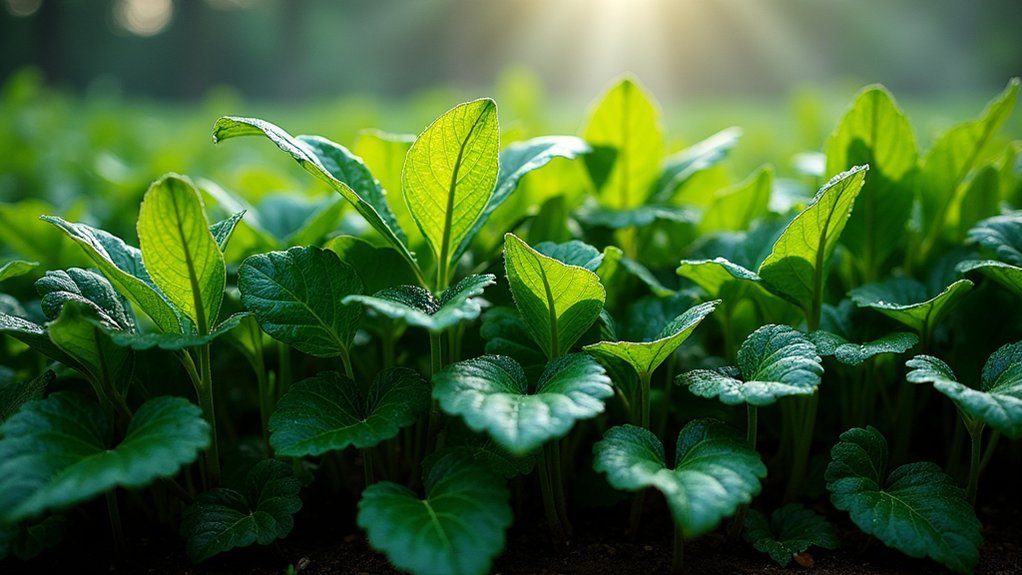



Leave a Reply